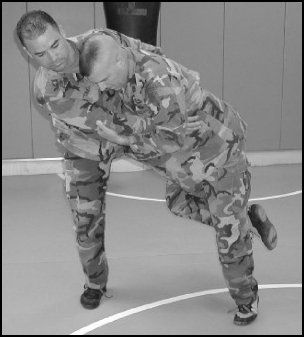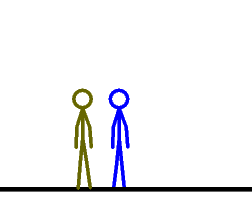
Grappling is a fighting technique based on throws, trips, sweeps, clinch fighting, ground fighting and submission holds.

Pankration was an unarmed combat sport introduced into the Greek Olympic Games in 648 BC. The athletes used boxing and wrestling techniques but also others, such as kicking, holds, joint-locks, and chokes on the ground, making it similar to modern mixed martial arts. The term comes from the Greek παγκράτιον, meaning 'all of power', from πᾶν (pan) 'all' and κράτος (kratos) 'strength, might, power'.

Brazilian jiu-jitsu is a self-defence martial art and combat sport based on grappling, ground fighting, and submission holds. BJJ focuses on taking ones opponent down to the ground, gaining a dominant position, and using a number of techniques to force them into submission via joint locks or chokeholds.
Professional wrestling throws are the application of professional wrestling techniques that involve lifting the opponent up and throwing or slamming them down. They are sometimes also called "power" maneuvers, as they are meant to emphasize a wrestler's strength. Many of these moves are used as finishers by various wrestlers, who refer to them by several different names that reflect their gimmick. Moves are listed under general categories whenever possible.
Professional wrestling holds include a number of set moves and pins used by performers to immobilize their opponents or lead to a submission. This article covers the various pins, stretches and transition holds used in the ring. Some wrestlers use these holds as their finishing maneuvers, often nicknaming them to reflect their character or persona. Moves are listed under general categories whenever possible.
A suplex is an offensive move used in sport wrestling, and brazilian jiu jitsu (bjj) as well as amateur wrestling and professional wrestling. It is a throw that involves lifting the opponents and bridging or rolling to slam them on their backs.
Aerial techniques, also known as "high-flying moves" are performance techniques used in professional wrestling for simulated assault on opponents. The techniques involve jumping from the ring's posts and ropes, demonstrating the speed and agility of smaller, nimble and acrobatically inclined wrestlers, with many preferring this style instead of throwing or locking the opponent.
Strikes can be offensive moves in professional wrestling, that can sometimes be used to set up an opponent for a hold or for a throw. There are a wide variety of strikes in pro wrestling, and many are known by several different names. Professional wrestlers frequently give their finishers new names. Occasionally, these names become popular and are used regardless of the wrestler performing the technique.

In martial arts and combat sports, a takedown is a technique that involves off-balancing an opponent and bringing them to the ground with the attacker landing on top. The process of quickly advancing on an opponent and attempting a takedown is known as shooting for a takedown, or simply shooting. Takedowns are usually distinguished from throws by amplitude and impact, where the purpose of a throw is to outright eliminate the opponent while purpose of a takedown is to bring the opponent down on the ground, assume a dominant position and then proceed to finish them with jointlocks, chokeholds, or ground and pound.

In professional wrestling, a pin is a move where a wrestler holds an opponent's shoulders to the mat in an attempt to score a fall. A pinfall is a common victory condition, where the attacker pins an opponent and the referee makes a three count before the opponent gets released from the pin.

The Boston crab is a professional wrestling hold that typically starts with one wrestler lying in a supine position on the mat, with the other wrestler standing and facing them. It is a type of spinal lock where the wrestler hooks each of the opponent’s legs in one of their arms and then turns the opponent face-down, stepping over them in the process. The final position has the wrestler in a semi-sitting position and facing away from the opponent, with the opponent’s back and legs bent back toward their head. The original name for the maneuver was the Backbreaker, before that term became known for its current usage. In modern wrestling, the Boston crab is not treated as a lethal submission maneuver, even though it was considered a match-ending hold in the past.

A powerbomb is a professional wrestling throw in which an opponent is lifted and then slammed back-first down to the mat. The standard powerbomb sees an opponent first placed in a standing headscissors position. The opponent is then lifted on the wrestler's shoulders and slammed down back-first to the mat. A prawn hold is commonly used for a pinning powerbomb.
In professional wrestling, a neckbreaker is any throw or slam that focuses its attack on the opponent's neck. One type of neckbreaker involves the wrestler slamming an opponent's neck against a part of the wrestler's body, usually the knee, head or shoulder. The other type of neckbreaker is a slam technique in which the wrestler throws an opponent to the ground by twisting the opponent's neck. This also refers to a "back head slam" where a wrestler drops to the mat while holding an opponent by their neck.
An armlock in grappling is a single or double joint lock that hyperextends, hyperflexes or hyperrotates the elbow joint or shoulder joint. An armlock that hyper-extends the elbow is known as an armbar, and it includes the traditional armbar, the shoulder triangle armbar, and the shotgun armbar. An armlock that hyper-rotates the arm is known as an armcoil, and includes the americana, kimura, and omaplata. Depending on the joint flexibility of a person, armcoils can either hyper-rotate only the shoulder joint, only the elbow joint, or both the elbow joint and shoulder joint.

A nelson hold is a grappling hold which is executed by one person from behind the opponent, generally when both are on the mat face down with the opponent under the aggressor. One or both arms are used to encircle the opponent's arm under the armpit, and secured at the opponent's neck. Several different nelson holds exist, and they can be separated according to the positioning of the encircling arm(s). A nelson is used to control an opponent or to turn them over onto their back and execute a pin.

A grappling hold, commonly referred to simply as a hold that in Japanese is referred to as katame-waza, is any specific grappling, wrestling, judo, or other martial art grip that is applied to an opponent. Grappling holds are used principally to control the opponent and to advance in points or positioning. The holds may be categorized by their function, such as clinching, pinning, or submission, while others can be classified by their anatomical effect: chokehold, headlock, joint-lock, or compression lock. Multiple categories may be appropriate for some of these holds.
A facebuster, also known as a faceplant, is generally a takedown move in professional wrestling in which an attacking wrestler forces their opponent down to the mat face-first without involving a headlock or facelock. A standard facebuster, also known as a jumping facebuster, involves the wrestler grabbing hold of the opponent's head/hair and dropping down to their knees, forcing the opponent's face into the mat.
A Powerslam or simply Slam is a professional wrestling body slam move in which the wrestler performing the slam falls face-down on top of the opponent. The use of the term "powerslam" usually refers to the front powerslam or the scoop powerslam.

A pin is a predicament in wrestling that ends a match regardless of when it occurs. Some situations that near pins but do not meet the criteria, such as having only one shoulder down or having the defending wrestler blocked in a neck bridge, are rewarded with exposure points known as near fall points or back points.
A wrestling move is a technique that helps you directly or indirectly win a wrestling match.










